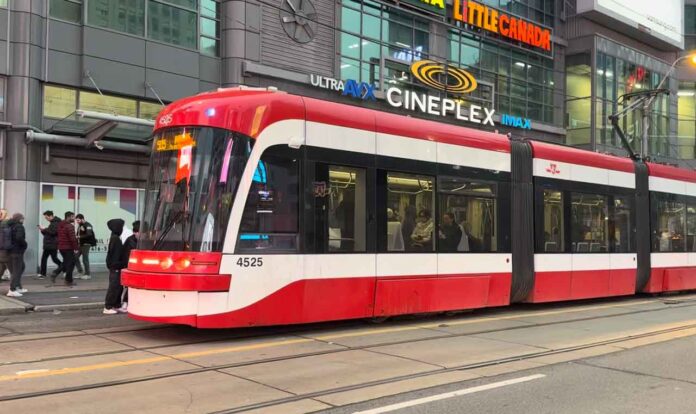Infra
Space to grow – Toronto has plenty of it
Naama Blonder, co-founder of Smart Density, a firm that combines architecture, urban planning and urban design to try to find a realistic ways to grow cities and provide affordable housing.Smart Density
Is Toronto maxed-out? Decidedly not, says architect and urban planner Naama Blonder. The city has space for 7.6-million new homes, which could house 12-million more residents, according to a new study by her firm.
The study was a theoretical exercise by Ms. Blonder, co-founder of Smart Density, a firm that combines architecture, urban planning and urban design in search of realistic ways to grow cities and provide affordable housing.
It found that there are 273 square kilometres of land close to transit available for dense housing in the city if – large tracts of single-family housing were to give way.
Ms. Blonder stresses that the study is not a blueprint for change: she is not recommending the wholesale bulldozing of Toronto’s single-family homes. But she says the study does show that the city is far from at capacity.
“This is not about how Toronto should be built,” says Ms. Blonder. “It’s just a counterpoint to people saying that we are maxed out.”
The study set out to remap the city of Toronto. Ms. Blonder was tired of hearing suggestions that growth should be redirected to exurban areas that supposedly have more room. As an immigrant, she says she knows that Toronto – a multicultural mixing pot – is where people want to live, not a small town two hours away.
“Our society is already very diverse,” she says. “Let’s keep it that way.”
The study zeroed in on land close to transit, within 800 metres of rapid transit and within 400 metres of frequent transit, for example the GO train, subway, streetcars or frequent buses. This included land currently designated as “neighbourhood” or “employment land” which, under current rules, is not open to high-density development.
The Toronto city plan currently directs almost all intensification to areas classified as “mixed-use and apartment neighbourhoods” which accounts for just 8.5 per cent of the city.
Using a data platform developed by Toronto-based software and data company Ratio. City, Ms. Blonder’s team found 273 square kilometres of land available for new homes, not including parks and open space.
The study divided this land into two types of development. The inner circle, closest to transit stations, would include the densest types of housing, for example 20- to 30-storey towers. The outer ring- somewhat farther from transit – is still suitable for development but less dense, for example, four storey, multi-family housing.
Toronto’s dense housing potential
According to a study by Smart Density, in Toronto there is 273 square kilometres of land in proximity to transit that would be suitable for dense housing, provided the city planning replaces single-family housing.
Bus/streetcar/rapid transit lines
Inner ring, areas closest to transit
Outer ring, areas farthest from transit
THE GLOBE AND MAIL, SOURCE: SMART DENSITY

Toronto’s dense housing potential
According to a study by Smart Density, in Toronto there is 273 square kilometres of land in proximity to transit that would be suitable for dense housing, provided the city planning replaces single-family housing.
Bus/streetcar/rapid transit lines
Inner ring, areas closest to transit
Outer ring, areas farthest from transit
THE GLOBE AND MAIL, SOURCE: SMART DENSITY

Toronto’s dense housing potential
According to a study by Smart Density, in Toronto there is 273 square kilometres of land in proximity to transit that would be suitable for dense housing, provided the city planning replaces single-family housing.
Bus/streetcar/rapid transit lines
Inner ring, areas closest to transit
Outer ring, areas farthest from transit
THE GLOBE AND MAIL, SOURCE: SMART DENSITY
This available land has capacity for 7.6 million new homes, says Ms. Blonder – enough to house 12-million new residents. Obviously, that would be excessive, she says; a dense city does not need to utilize every piece of available land. But it highlights how much potential land is available.
“We have this rhetoric of ‘We’re maxed out.’ But when you actually look at the data, it doesn’t support that claim.”
The area around Glencarin subway station is an example of a neighbourhood that could host many more homes, she says. Close to numerous transit lines but with a built environment dominated by single-family homes, the neighbourhood is an inefficient use of land. Bloor-Danforth, stretching from downtown Toronto to the fringes of Scarborough and Sheppard-Yonge in the north end of the city are other examples of areas with an overabundance of single-family homes clinging to a major subway line. Neighbourhoods like these are the relics of the postwar period when urban planners built single-family housing stock but few low-rise apartment buildings. Ms. Blonder says areas close to transit but designated as “employment land” for the use of light industry are another inefficient use of land.
The removal of single-family homes to build denser housing will come with infrastructure challenges, Ms. Blonder says. But this should be seen as an investment, not something that stands in the way of growth. Density will also be a driver of improved social infrastructure – from libraries to community centres.
Studies like Ms. Blonder’s are useful, said Karen Chapple, director of the School of Cities at the University of Toronto and professor of geography and planning. They show how inefficiently we are using land, she says. They also serve to raise other questions. For example, what is transit capacity in Toronto? Can the city increase the number of trains, or the speed of the trains? Or do city planners need to think about diversity of transit? For example, offering bike lanes, car shares, or autonomous car sharing. Infrastructure must also be built with the accessibility needs of children, the elderly or physically challenged people in mind.
Such models are useful because they highlight deficiencies, she says.
“Even if we just built 10 per cent of that, we could probably accommodate our future needs.”
Radically rethinking the density of Toronto will require residents to change how they understand neighbourhoods and the concept of a home, says Ms. Blonder. In cities across Europe, residents raise children in condos and apartments, rentals are more common, and a backyard is not seen as the only way to benefit from green space. Should Toronto wish to be more dense – and maintain a reputation as a bustling, multicultural metropolis – it needs to break some long-held ideas of how a city, and a family home, can look.
“We need to have a broader conversation on whether we are using what we have in the best way possible.”










